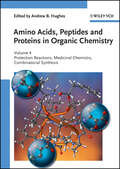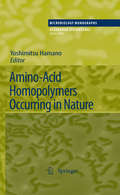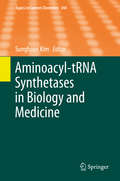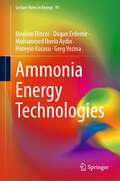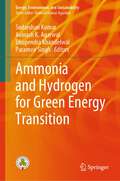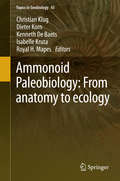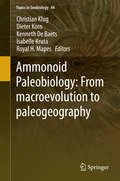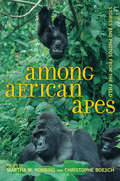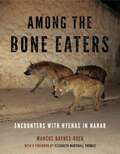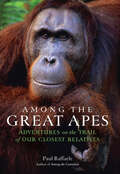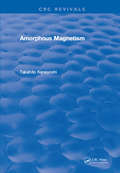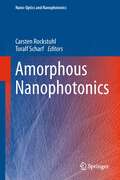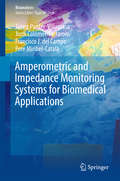- Table View
- List View
Amino Acids in Nutrition and Health: Amino Acids in Gene Expression, Metabolic Regulation, and Exercising Performance (Advances in Experimental Medicine and Biology #1332)
by Guoyao WuThis book explains about amino acids (AAs) which are not only building blocks of protein, but are also signaling molecules as well as regulators of gene expression and the protein phosphorylation cascade. Additionally, AAs are key precursors for syntheses of hormones and low-molecular-weight nitrogenous substances with each having enormous biological importance. For example, physiological concentrations of AA metabolites (e.g., nitric oxide, polyamines, glutathione, taurine, thyroid hormones, and serotonin) are required for cell functions. Growing evidence shows that humans and animals have dietary requirements for all proteinogenic AAs. Mammals, birds, and fish also have species- and age-dependent needs for some AA-related substances. However, elevated levels of other products (e.g., ammonia, homocysteine, H2S, and asymmetric dimethylarginine) are pathogenic factors for neurological disorders, oxidative stress, and cardiovascular disease. Thus, optimal amounts of AAs and their ratios in diets and circulation are crucial for whole-body homeostasis and health. Adequate provision of one or a mixture of functional AAs or metabolites may be beneficial for ameliorating health problems at various stages of the life cycle (e.g., fetal growth restriction, neonatal morbidity and mortality, weaning-associated intestinal dysfunction and wasting syndrome, obesity, diabetes, cardiovascular disease, the metabolic syndrome, and infertility). Dietary supplementation of these nutrients can also optimize the efficiency of metabolic transformations to enhance muscle growth, milk production, and athletic performance, while preventing excess fat deposition and reducing adiposity. Therefore, functional AAs hold great promise in improving the growth, health, and well-being of individuals.
Amino Acids in Nutrition and Health: Amino Acids in the Nutrition of Companion, Zoo and Farm Animals (Advances in Experimental Medicine and Biology #1285)
by Guoyao WuAmino acids (AAs) are not only building blocks of protein, but are also signalling molecules as well as regulators of gene expression and the protein phosphorylation cascade. Additionally, AAs are key precursors for syntheses of hormones and low-molecular weight nitrogenous substances with each having enormous biological importance. For example, physiological concentrations of AA metabolites (e.g., nitric oxide, polyamines, glutathione, taurine, thyroid hormones, and serotonin) are required for cell functions. Growing evidence shows that humans and animals have dietary requirements for all proteinogenic AAs. Mammals, birds and fish also have species- and age-dependent needs for some AA-related substances. However, elevated levels of other products (e.g., ammonia, homocysteine, H2S, and asymmetric dimethylarginine) are pathogenic factors for neurological disorders, oxidative stress, and cardiovascular disease. Thus, optimal amounts of AAs and their ratios in diets and circulation are crucial for whole body homeostasis and health. Adequate provision of one or a mixture of functional AAs or metabolites may be beneficial for ameliorating health problems at various stages of the life cycle (e.g., fetal growth restriction, neonatal morbidity and mortality, weaning-associated intestinal dysfunction and wasting syndrome, obesity, diabetes, cardiovascular disease, the metabolic syndrome, and infertility). Dietary supplementation of these nutrients can also optimize the efficiency of metabolic transformations to enhance muscle growth, milk production, and athletic performance, while preventing excess fat deposition and reducing adiposity. Therefore, functional AAs hold great promise in improving the growth, health and well-being of individuals.Chapter 7 is available open access under a Creative Commons Attribution 4.0 International License via link.springer.com.
Amino Acids in Nutrition and Health: Amino acids in systems function and health (Advances in Experimental Medicine and Biology #1265)
by Guoyao WuThis edited volume comprehensively highlights recent advances in the metabolism, nutrition, physiology, and pathobiology of amino acids in all the systems of humans and other animals (including livestock, poultry, companion animals, and fish). It enables readers to understand the crucial roles of amino acids and their metabolites in the health and diseases of the circulatory, digestive, endocrine, immune, muscular, nervous, reproductive, respiratory, skeletal, and urinary systems, as well as the sense organs (eyes, ears, nose, skin, and tongue). Readers will learn that amino acids are not only the building blocks of protein, but are also signalling molecules, as well as regulators of gene expression, metabolic processes and developmental changes in the body. This knowledge will guide nutritional practices to improve the growth, development and health of humans and other animals, as well as prevent and treat chronic (e.g., obesity, diabetes, and cardiovascular disorders) and infectious (e.g., bacterial, fungal, parasite, and viral) diseases. Editor of this volume is an internationally recognized expert in nutritional biochemistry. He has over 38 years of experience with research and teaching at world-class universities in the area of amino acid biochemistry, nutrition, and physiology. He has published more than 625 papers in peer-reviewed journals, 62 chapters in books, and authored two text/reference books, with an H-index of 117 and more than 55,000 citations in Google Scholar. This publication is a useful reference for professionals as well as undergraduate and graduate students in animal science, biochemistry, biomedical engineering, biology, human medicine, food science, kinesiology, nursing, nutrition, pharmacology, physiology, toxicology, veterinary medicine, and other related disciplines. In addition, all chapters provide general and specific references to amino acids in systems health for researchers and practitioners in biomedicine, animal and plant agriculture, and aquaculture, and for government policy makers.
Amino Acids, Peptides and Proteins in Organic Chemistry, Building Blocks, Catalysis and Coupling Chemistry (Amino Acids, Peptides and Proteins in Organic Chemistry (VCH) #6)
by Andrew B. HughesThis is the third of five books in the Amino Acids, Peptides and Proteins in Organic Synthesis series. Closing a gap in the literature, this is the only series to cover this important topic in organic and biochemistry. Drawing upon the combined expertise of the international "who's who" in amino acid research, these volumes represent a real benchmark for amino acid chemistry, providing a comprehensive discussion of the occurrence, uses and applications of amino acids and, by extension, their polymeric forms, peptides and proteins. The practical value of each volume is heightened by the inclusion of experimental procedures. The 5 volumes cover the following topics: Volume 1: Origins and Synthesis of Amino Acids Volume 2: Modified Amino Acids, Organocatalysis and Enzymes Volume 3: Building Blocks, Catalysis and Coupling Chemistry Volume 4: Protection Reactions, Medicinal Chemistry, Combinatorial Synthesis Volume 5: Analysis and Function of Amino Acids and Peptides This third volume in the series presents an in depth account of recent developments in the (bio-)synthesis of amino acids and peptides. Divided into two parts, the first section deals with amino acids as building blocks, including the generation of alpha-amino acids, beta-lactams, and heterocycles. The second section is devoted to the synthesis of peptides, with the focus on solid phase synthesis. However, solution phase peptide synthesis is covered as well, as are topics such as coupling reagents, chemical ligation, peptide purification and automation. Originally planned as a six volume series, Amino Acids, Peptides and Proteins in Organic Chemistry now completes with five volumes but remains comprehensive in both scope and coverage. Further information about the 5 Volume Set and purchasing details can be viewed here.
Amino Acids, Peptides and Proteins in Organic Chemistry, Protection Reactions, Medicinal Chemistry, Combinatorial Synthesis (Amino Acids, Peptides and Proteins in Organic Chemistry (VCH) #6)
by Andrew B. HughesThis is the fourth of five books in the Amino Acids, Peptides and Proteins in Organic Synthesis series. Closing a gap in the literature, this is the only series to cover this important topic in organic and biochemistry. Drawing upon the combined expertise of the international "who's who" in amino acid research, these volumes represent a real benchmark for amino acid chemistry, providing a comprehensive discussion of the occurrence, uses and applications of amino acids and, by extension, their polymeric forms, peptides and proteins. The practical value of each volume is heightened by the inclusion of experimental procedures. The 5 volumes cover the following topics: Volume 1: Origins and Synthesis of Amino Acids Volume 2: Modified Amino Acids, Organocatalysis and Enzymes Volume 3: Building Blocks, Catalysis and Coupling Chemistry Volume 4: Protection Reactions, Medicinal Chemistry, Combinatorial Synthesis Volume 5: Analysis and Function of Amino Acids and Peptides The fourth volume in this series is structured in three main sections. The first section is about protection reactions and amino acid based peptidomimetics. The second, and most extensive, part is devoted to the medicinal chemistry of amino acids. It includes, among others, the chemistry of alpha- and beta amino acids, peptide drugs, and advances in N- and O-glycopeptide synthesis. The final part deals with amino acids in combinatorial synthesis. Methods, such as phage display, library peptide synthesis, and computational design are described. Originally planned as a six volume series, Amino Acids, Peptides and Proteins in Organic Chemistry now completes with five volumes but remains comprehensive in both scope and coverage. Further information about the 5 Volume Set and purchasing details can be viewed here.
Amino Acids: Biochemistry and Nutrition
by Guoyao WuFollowing its predecessor, the second edition of Amino Acids: Biochemistry and Nutrition presents exhaustive coverage of amino acids in the nutrition, metabolism and health of humans and other animals. Substantially revised, expanded and updated to reflect scientific advances, this book introduces the basic principles of amino acid biochemistry and nutrition, while highlighting the current knowledge of the field and its future possibilities. The book begins with the basic chemical concepts of amnio acids, peptides and proteins, and their digestion and absorption. Subsequent chapters cover cell-, tissue-, and species-specific synthesis and catabolism of amino acids and related bioactive metabolites, and the use of isotopes to study amino acids metabolism in cells and the body. The book details protein turnover, physiological functions of amino acids, as well as both the regulation and inborn errors of amino acid metabolism. The book concludes with a presentation on human and animal dietary requirements of amino acids and evaluates dietary protein quality. Features: Encompasses a comprehensive coverage of basic to applied concepts in amino acid metabolism in humans and other animals. Highlights important roles of dietary amino acids and protein intake in growth, physical performance and health, including sarcopenia mitigation and immunity. Discusses concerns over the excess intakes of amino acids or protein in the development of diseases, including cardiovascular disorders, diabetes and cancers, as well as bone integrity Each chapter contains select references to provide comprehensive reviews and original experimental data on the topics discussed. Each chapter is backed by original experimental data on various topics discussed and contains select references to aid the reader further in research. Written by Distinguished Professor of Animal Nutrition, Guoyao Wu, Ph.D., this book is an authoritative reference for students and researchers in both biomedicine and agriculture.
Amino-Acid Homopolymers Occurring in Nature (Microbiology Monographs #15)
by Yoshimitsu HamanoMicroorganisms are capable of producing a wide variety of biopolymers. Homopolymer peptides, which are made up of only a single type of amino acid, are far less ubiquitous. The only two amino-acid homopolymers known to occur in nature are presented in this volume. Poly-epsilon-L-lysine is a polycationic peptide and exhibits antimicrobial activity against a wide spectrum of microorganisms. It is both safe and biodegradable and is therefore used as a food preservative in several countries. In addition, there has been great interest in medical and other applications of poly-lysine and its derivatives. In contrast, poly-gamma-glutamic acid is an unusual anionic polypeptide. It is also water soluble, biodegradable, edible, non-toxic and non-immunogenic and can be chemically modified to introduce various drugs. These features are very useful for pharmaceutical and biomedical applications. Poly-glutamic acid is also a highly attractive as a food ingredient.
Aminoacyl-tRNA Synthetases in Biology and Medicine (Topics in Current Chemistry #344)
by Sunghoon KimThis book will focus on new molecular interactions and novel activities and the associated diseases that have been recently discovered from the studies of eukaryotic and mammalian aminoacyl-tRNA synthetases. In addition, the potential applications of ARS researches in biotechnology and medicine will be addressed.
Ammonia Energy Technologies (Lecture Notes in Energy #91)
by Ibrahim Dincer Dogan Erdemir Muhammed Iberia Aydin Huseyin Karasu Greg VezinaThis book is the first to cover all aspects of using ammonia for energy - from production to last use. The book explains the fundamentals and basic concepts about hydrogen and ammonia before examining their production methods. Then it covers ammonia production and storage techniques. Furthermore, the book contains case studies that demonstrate the use of ammonia technology. Ammonia energy systems are explained, and the technologies and methods used with them are explained with illustrative examples. Finally, the book lays out future directions in the development of ammonia energy systems. It is expected that the book will be of interest to all researchers and professionals interested in new energy sources.
Ammonia and Hydrogen for Green Energy Transition (Energy, Environment, and Sustainability)
by Avinash K. Agarwal Sudarshan Kumar Bhupendra Khandelwal Paramvir SinghThe subject of this book pertains to the applicability of zero-carbon vector fuels, such as ammonia or hydrogen, in a practical scenario. This monograph extensively discusses the applicability or challenges associated with ammonia fuels for both IC-engine and gas turbine applications. It provides insights into ammonia cracking through catalytic membrane reactors for hydrogen production. This book also discusses NOx mitigation techniques for ammonia combustion, such as MILD combustion, two-stage combustion, porous assisted combustion, plasma combustion, and high-pressure combustion. This book also provides details on the chemical kinetics of ammonia and hydrogen combustion. The book can be a valuable reference for researchers and professionals interested in green energy and allied fields.
Ammonium Nitrate Explosives for Civil Applications: Slurries, Emulsions and Ammonium Nitrate Fuel Oils
by Erode G. MahadevanThe book describes the science and technology of formulation and manufacturing of non-nitroglycerine explosives with ammonium nitrate as the main ingredient. Based on the author's industry experience of more than thirty years, it provides an unparalleled treatment of one of the commercially most important classes of explosives and therefore stimulates further research and development efforts in the field of explosives for civil applications.
Ammonoid Paleobiology: From Anatomy To Ecology (Topics in Geobiology #43)
by Christian Klug Dieter Korn Kenneth De Baets Isabelle Kruta Royal H. MapesThis two-volume work is a testament to the abiding interest and human fascination with ammonites. We offer a new model to explain the morphogenesis of septa and the shell, we explore their habitats by the content of stable isotopes in their shells, we discuss the origin and later evolution of this important clade, and we deliver hypotheses on its demise. The Ammonoidea produced a great number of species that can be used in biostratigraphy and possibly, this is the macrofossil group, which has been used the most for that purpose. Nevertheless, many aspects of their anatomy, mode of life, development or paleobiogeographic distribution are still poorly known. Themes treated are biostratigraphy, paleoecology, paleoenvironment, paleobiogeography, evolution, phylogeny, and ontogeny. Advances such as an explosion of new information about ammonites, new technologies such as isotopic analysis, tomography and virtual paleontology in general, as well as continuous discovery of new fossil finds have given us the opportunity to present a comprehensive and timely "state of the art" compilation. Moreover, it also points the way for future studies to further enhance our understanding of this endlessly fascinating group of organisms.
Ammonoid Paleobiology: From Macroevolution To Paleogeography (Topics in Geobiology #44)
by Christian Klug Dieter Korn Kenneth De Baets Isabelle Kruta Royal H. MapesThis two-volume work is a testament to the abiding interest and human fascination with ammonites. We offer a new model to explain the morphogenesis of septa and the shell, we explore their habitats by the content of stable isotopes in their shells, we discuss the origin and later evolution of this important clade, and we deliver hypotheses on its demise. The Ammonoidea produced a great number of species that can be used in biostratigraphy and possibly, this is the macrofossil group, which has been used the most for that purpose. Nevertheless, many aspects of their anatomy, mode of life, development or paleobiogeographic distribution are still poorly known. Themes treated are biostratigraphy, paleoecology, paleoenvironment, paleobiogeography, evolution, phylogeny, and ontogeny. Advances such as an explosion of new information about ammonites, new technologies such as isotopic analysis, tomography and virtual paleontology in general, as well as continuous discovery of new fossil finds have given us the opportunity to present a comprehensive and timely "state of the art" compilation. Moreover, it also points the way for future studies to further enhance our understanding of this endlessly fascinating group of organisms.
Ammonothermal Synthesis and Crystal Growth of Nitrides: Chemistry and Technology (Springer Series in Materials Science #304)
by Elke Meissner Rainer NiewaThis book provides a collection of contributed chapters, delivering a comprehensive overview of topics related to the synthesis and crystal growth of nitride compounds under supercritical ammonia conditions. Focusing on key chemical and technological aspects of ammonothermal synthesis and growth of functional nitride compounds, the book also describes many innovative techniques for in-situ observation and presents new data fundamental for materials synthesis under ammonothermal conditions. With its detailed coverage of many thermodynamic and kinetics aspects, which are necessary for understanding and controlling crystal growth, this contributed volume is the ideal companion to materials chemists and engineers at any point in their journey in this rich and exciting field.
Amniotic Membrane: Origin, Characterization and Medical Applications
by Ana Catarina Mamede Maria Filomena BotelhoThis book describes the human amniotic membrane from its origin, characterization and medical applications, summarizing all the latest developments and findings related to this tissue with contributions from some of the leading researchers in the field. The book addresses issues for its preservation, separation and identification of amniotic membrane-derived cells, as well as the potential ethical issues involved in their use. The topic of this book is particularly pertinent for clinicians and researchers involved in the research and use of this tissue.
Among African Apes
by Martha M. Robbins Christophe BoeschThese compelling stories and photographs take us to places like Bwindi Impenetrable National Park in Uganda, Ivindo National Park in Gabon, and the Taï National Park in Côte d'Ivoire for an intimate and revealing look at the lives of African wild apes--and at the lives of the humans who study them. In tales of adventure, research, and conservation, veteran field researchers and conservationists describe exciting discoveries made over the past few decades about chimpanzees, bonobos, and gorillas. The book features vivid descriptions of interactions among these highly intelligent creatures as they hunt, socialize, and play. More difficult themes emerge as well, including the threats apes face from poaching, disease, and deforestation. In stories that are often moving and highly personal, this book takes measure of how special the great apes are and discusses positive conservation efforts, including ecotourism, that can help bring these magnificent animals back from the brink of extinction.
Among Flowers: A Walk in the Himalaya
by Jamaica KincaidAnyone familiar with Jamaica Kincaid's work knows that the natural world and in particular, plants and gardening are especially close to her heart. In this vivid account she invites us to accompany her on a seed-gathering trek in the Himalaya. For Kincaid and three botanist friends, Nepal is a paradise a place where a single day's hike can traverse climate zones from sub-tropical to alpine encompassing flora suitable for growing in their home grounds from Wales to Vermont. A wonderful blend of introspective insight and beautifully rendered description, Among Flowers is a seriously entertaining thoroughly engaging and characteristically frank memoir from one of the most distinctive and striking voices writing today.
Among the Bone Eaters: Encounters with Hyenas in Harar (Animalibus: Of Animals and Cultures #8)
by Elizabeth Marshall Thomas Marcus Baynes-RockBiologists studying large carnivores in wild places usually do so from a distance, using telemetry and noninvasive methods of data collection. So what happens when an anthropologist studies a clan of spotted hyenas, Africa’s second-largest carnivores, up close—and in a city of a hundred thousand inhabitants? In Among the Bone Eaters, Marcus Baynes-Rock takes us to the ancient city of Harar in Ethiopia, where the gey waraba (hyenas of the city) are welcome in the streets and appreciated by the locals for the protection they provide from harmful spirits and dangerous “mountain” hyenas. They’ve even become a local tourist attraction.At the start of his research in Harar, Baynes-Rock contended with difficult conditions, stone-throwing children, intransigent bureaucracy, and wary hyena subjects intent on avoiding people. After months of frustration, three young hyenas drew him into the hidden world of the Sofi clan. He discovered the elements of a hyena’s life, from the delectability of dead livestock and the nuisance of dogs to the unbounded thrill of hyena chase-play under the light of a full moon. Baynes-Rock’s personal relations with the hyenas from the Sofi clan expand the conceptual boundaries of human-animal relations. This is multispecies ethnography that reveals its messy, intersubjective, dangerously transformative potential.
Among the Great Apes: Adventures on the Trail of Our Closest Relatives
by Paul Raffaele“Raffaele spins riveting tales of his mission to visit every species and subspecies of great ape in its natural habitat.” —Discover magazineAward winning adventure journalist Paul Raffaele’s Among the Great Apes is the first book in over a decade—and possibly the last ever—to take its readers into the lives of our charismatic cousins in their native habitats. Humans have long felt a deep attraction to the great apes: bonobos, chimpanzees, orangutans, and gorillas. We see a reflection of ourselves in their faces, mannerisms, and interactions with kin. But we also look to them for contrast. Part of how we define ourselves as human rests with recognizing the differences between us and the great apes, in spite of the substantial amounts of DNA we share.Many great primatologists have dedicated their lives to the observation and study of these species in their natural habitats. Unfortunately, many of these sheltering places no longer exist. The great apes live in some of the most volatile regions on our planet, lands plagued by civil unrest, poverty, environmental degradation, and corrupt governments. In this book, Raffaele goes into the wild to see how our closest relatives are faring today. He takes us through isolated jungles and misty mountain forests, sharing wonderfully intimate observations of ape life paired with the most current research about their behavior.Raffaele, called the “last of the great, old-fashioned adventure writers” by the Washington Post, introduces us to leading conservationists and researchers working to save and study the apes. But best of all, he gets up close to these amazing animals. He describes orangutans fashioning umbrellas from long leaves, a young chimpanzee mothering a “baby” log, and the bonobos’ lively ritual of swinging like gymnasts through the treetops before building elaborate nests to sleep in. Moving from Borneo to the Congo, Among the Great Apes brings us to the natural habitats of all the species and subspecies of the great apes—a trip possible for perhaps the last time.“A powerful account of the author’s journey into our planet’s last remaining gorilla communities.” —The Ecologist“Fantastic. . . . Anyone who cares about animals will benefit hugely from reading it.” —Shaun Ellis, star of Animal Planet’s Living with the Wolfman and author of The Man Who Lives with Wolves“Profound and important . . . Raffaele shows us how amazing interesting and complex great apes are.” —David Greer, coordinator, World Wildlife Fund’s African Great Apes Program
Amorphous Magnetism
by Takahito KaneyoshiThis book presents some of the methods used in the theory of amorphous magnetism, from a single standpoint that amorphous magnets have a topologically disordered structure of the type given by the dense random packing of hard spheres.The primary aim is to show systematically the present theoretical apparatus in a form which would allow the reader to use it in investigations of still unsolved problems. Even within these limits, the theory of amorphous magnetism is now a very large subject. This book is not designed to review all the developments in this rapidly developing area. It is primarily intended for the novice in this field, rather than the specialist.
Amorphous Nanophotonics (Nano-Optics and Nanophotonics)
by Carsten Rockstuhl Toralf ScharfThis book represents the first comprehensive overview over amorphous nano-optical and nano-photonic systems. Nanophotonics is a burgeoning branch of optics that enables many applications by steering the mould of light on length scales smaller than the wavelength with devoted nanostructures. Amorphous nanophotonics exploits self-organization mechanisms based on bottom-up approaches to fabricate nanooptical systems. The resulting structures presented in the book are characterized by a deterministic unit cell with tailored geometries; but their spatial arrangement is not controlled. Instead of periodic, the structures appear either amorphous or random. The aim of this book is to discuss all aspects related to observable effects in amorphous nanophotonic material and aspects related to their design, fabrication, characterization and integration into applications. The book has an interdisciplinary nature with contributions from scientists in physics, chemistry and materials sciences and sheds light on the topic from many directions.
Amorphous-Nanocrystalline Alloys
by A. M. Glezer N. A. ShuryginaAmorphous-nanocrystalline alloys are a relatively new class of materials born from the rapid development of new technologies and different methods of producing amorphous and nanocrystalline powders and films, compacting, melt quenching, megaplastic deformation, implantation, laser, plasma, and other high-energy methods. This book considers methods of producing these materials (melt quenching, controlled crystallization, deformation effect, and pulse treatments (photon, laser and ultrasound), spraying thin films, and ion implantation). Theoretical and experimental studies describe plastic deformation mechanisms and physico-mechanical properties. Practical applications are also presented.
Amos's Killer Concert Caper
by Gary PaulsenAmos is desperate. He's desperate for two tickets to the romantic event of his young life...the Road Kill concert! He'll do anything to get them because he heard from a friend of a friend of a friend of Melissa Hansen that: she's way into Road Kill.
Amperometric and Impedance Monitoring Systems for Biomedical Applications (Bioanalysis #4)
by Jordi Colomer-Farrarons Jaime Punter-Villagrasa Francisco J. del Campo Pere Miribel-CatalàThe book presents the conception and realization of a pervasive electronic architecture for electrochemical applications, focusing on electronic instrumentation design and device development, particularly in electrochemical Point-of-Care and Lab-on-a-Chip devices, covering examples based on amperometric (DC) and impedance detection (AC) techniques. The presented electronics combine tailored front-end instrumentation and back-end data post-processing, enabling applications in different areas, and across a variety of techniques, analytes, transducers and environments. It addresses how the electronics are designed and implemented with special interest in the flow process: starting from electronic circuits and electrochemical biosensor design to a final validation and implementation for specific applications. Similarly, other important aspects are discussed throughout the book, such as electrochemical techniques, different analytes, targets, electronics reliability and robustness. The book also describes the use of the presented electronics in different electrochemical applications through some examples: instantaneous and non-destructive cellular monitoring and portable glucose monitoring device. Moreover, the book aims to introduce a comprehensive approach to electronic circuits, techniques and electrochemical sensors in POC devices to a general audience of students in biomedical and electronics engineering, scientists, and engineers.
Amphibian Declines: The Conservation Status of United States Species
by Michael J. LannooThe recent, sudden and dramatic decline in the abundance of amphibians is a world-wide environmental crisis. The cause of this decline is not known but many possibilities are reviewed in this mammoth 1000 page tome. This book describes in exhaustive and comprehensive detail the demise of amphibians throughout the world.




